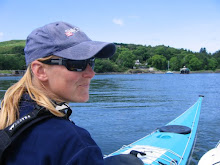I can't help thinking that there is something comical about puffins in their bright colourscheme of the breeding season. Their beaks seem out of all proportion with their heads and their tiny wings flap nineteen to the dozen in an attempt to get aloft.
As we rounded the northernmost part of the island we were met by a multicoloured array of kayaks pulled up on the slippery landing area of Inner Farne. The group was huge so we didn't stop but paddled quickly across Staple Sound to Longstone, where Jimski and I had an appointment with a pack of chocolate profitteroles. Lunch consumed and Jimski decided it was time for a swim.
Meanwhile I went exploring round the rocks of Longstone and found this sleepy chap.
Longstone lighthouse in the sunshine.
On our journey back to shore we detoured via Inner Farne where this time we landed to visit the Terns. Here is Mr Arctic Tern trying to attract the attention of a potential Mrs Arctic Tern with a present of a sand eel. She doesn't look too impressed.
We landed back where we started at St Aiden's dunes aided by a favourable tidal stream and complete lack of surf. This was a fantastic day out and one I hope to repeat many times.






















